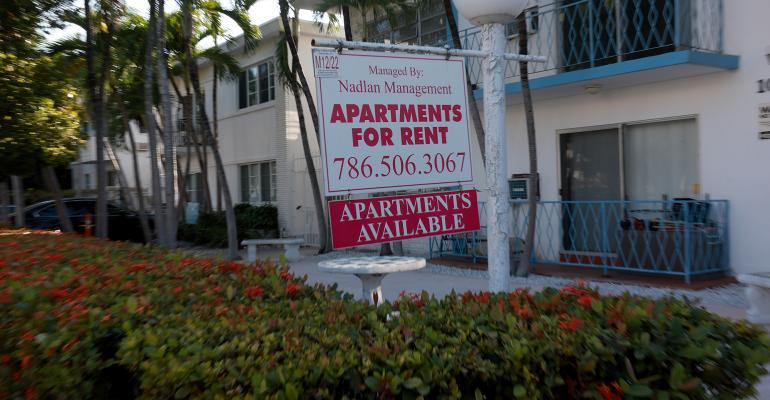(Bloomberg Opinion) -- For most of the past year, investment risk in the housing market has been focused on the for-sale segment. That was largely because the huge run-up in home prices during the pandemic led to a mentality of “what goes up must come down,” coupled with long memories of the housing bust in the late 2000s. But the data we’ve gotten over the past several months suggest that it's the rental part of the housing market that's setting up for a hard landing.
Declining rents in 2023 should be the base case at this point, with the only question now being how far they will drop? And while tenants will cheer this possibility, the worry is that it will destroy the pipeline of new supply for years to come.
The risks growing in the rental market are surprising because the turnaround has been so sudden. Tenants are still reeling from multiple years of steep gains. The first hints of the downturn showed up just three months ago, after weak apartment demand in the third quarter led to seasonality returning to rental prices.
It's gotten steadily worse since then. According to Apartment List, rents fell nationally every month in the fourth quarter. Rents falling in the fourth quarter is in-line with the pre-pandemic seasonal norm, but the magnitude of the declines are bigger than what we saw between 2017 and 2019. Rents fell nationally by an average of 0.9% a month in the fourth quarter, versus a 2017-19 average that was half that. In a typical year rents grow by about 3%, so that suggests rents fell by 3% in the last three months of 2022 on a seasonally adjusted annualized basis.
Why has the rental market turned so weak? As rental housing economist Jay Parsons points out, new lease demand cratered in the second half of the year, and was negative for the full year for the first time since 2009.
During the pandemic, there was an explosion in the number of single-person households formed, and they largely moved into apartments, in many cases replacing the people who contributed so much to home-buying demand during the same time. Just as we saw in e-commerce and streaming services, the rental market pulled forward demand from the future. And it took until the second half of 2022 for that demand to be exhausted, leading to fewer lease signings, rising vacancies and falling rents.
Ominously for the rental market, it isn’t clear that developers and investors are prepared for a period of softness. The national apartment vacancy rate rose to 5.9% in December, its highest level since April 2021, and has been rising by 0.2% a month recently, according to Apartment List. At that pace the vacancy rate would be at its pre-pandemic level by April.
All this is happening while there are more apartment units under construction than there have been in more than 50 years, which will dump even more supply onto the market. Even before accounting for the possibility of job losses and a recession in 2023, this increased supply will create more vacancies.
There are a couple of important pieces to this puzzle that go beyond just another industry shifting from a pandemic boom to a post-pandemic bust. The first is that the rental industry didn't go through the near-death experience that the for-sale housing market did in the late 2000s. Leading up to the 2008 recession, the industry was focused on building detached homes for sale rather than apartments, so if anything there was an undersupply of apartments at that time. Homeowners who lost their homes had to live somewhere, so they rented, which supported the rental market.
And then the entry into the workforce of millions of young members of the millennial generation was better for rental than ownership demand at the time. So whereas homebuilders, who tend to be more nationally focused, became more conservative in the 2010s, multifamily developers, who are more local and regional, were intent on building as many apartments as they could to meet the demand from young millennials.
But as Bill McBride of Calculated Risk has pointed out, millennials are now at the age where they are more likely to want to buy homes than rent them. The country’s demographics in the 2020s are tilted toward ownership, not renting. So as the housing market recovers from this soft patch, we should expect the for-sale market to recover more strongly than the rental market.
The hope is the rental-market adjustment we get in 2023 is orderly — tenants get a break on rent prices, investors take some losses, the market rebalances and life moves on in 2024. The risk is something more chaotic: capital dries up, multifamily developers go bankrupt and new construction plunges, leading to years of subdued building in the years ahead. The time to raise alarms is now — this situation is ugly, and it's going to get worse before it gets better.
More From Bloomberg Opinion:
- Housing Market Doesn't Need Much for Buyers to Return: Conor Sen
- Waiting for Home Prices to Drop? Bad Strategy: Alexis Leondis
- Renters Are Finally Catching a Break From Price Hikes: Conor Sen
Want more Bloomberg Opinion? OPIN <GO>. Or subscribe to our daily newsletter.
To contact the author of this story: Conor Sen at [email protected]
© 2023 Bloomberg L.P.





